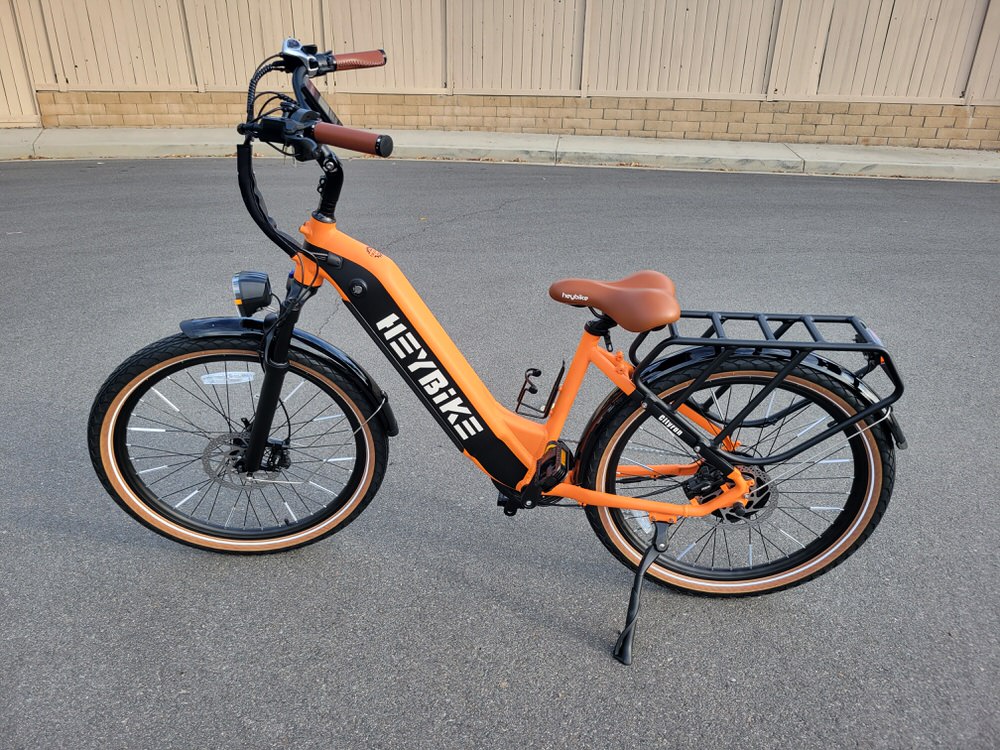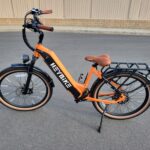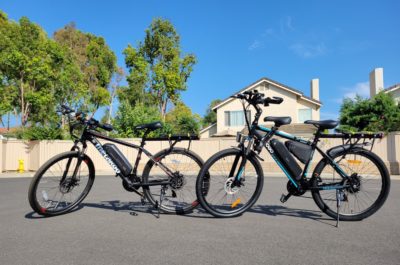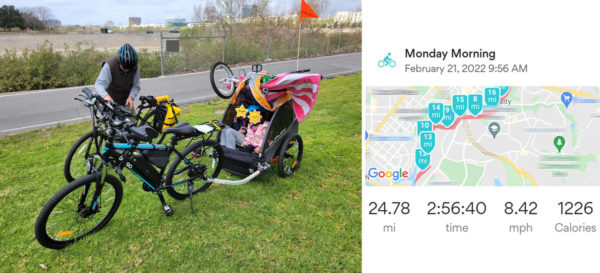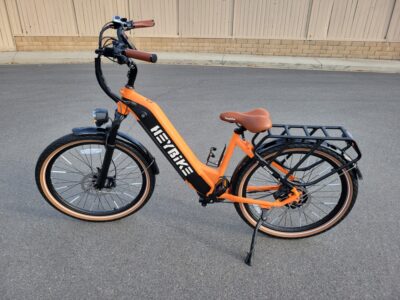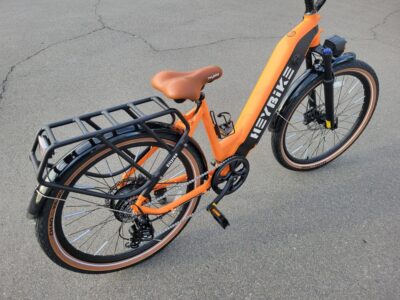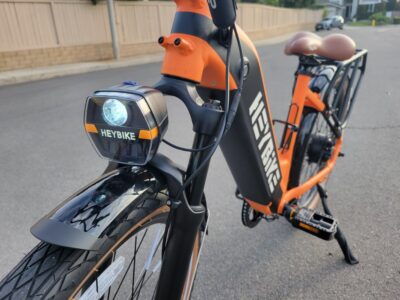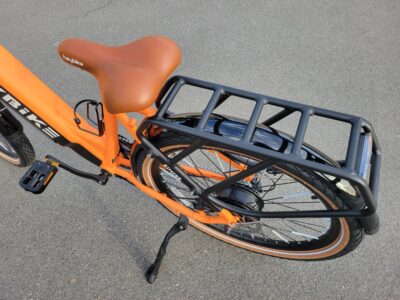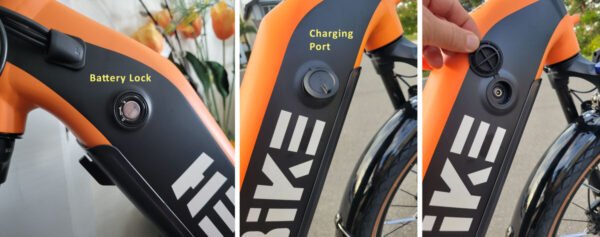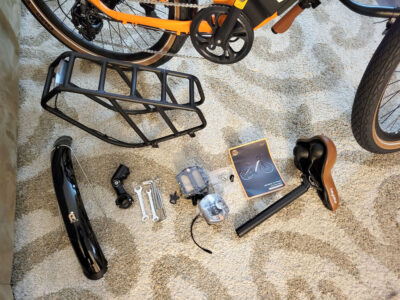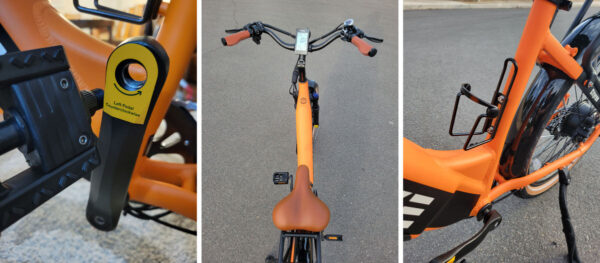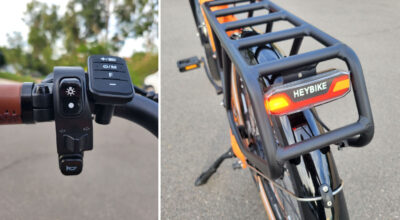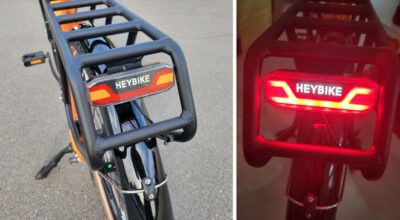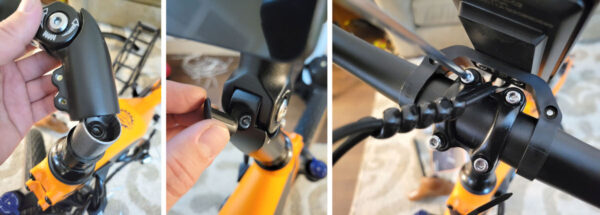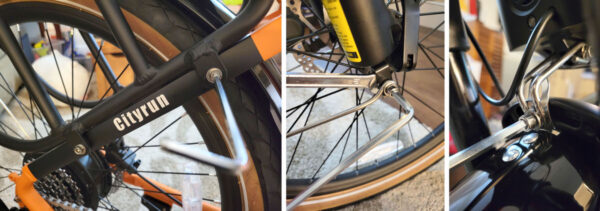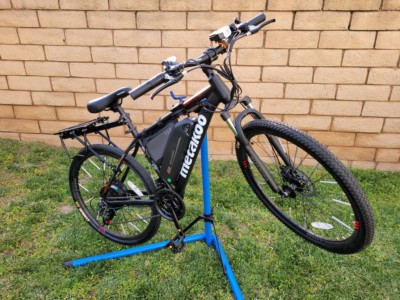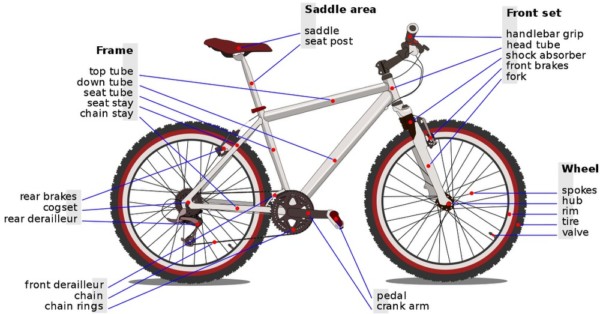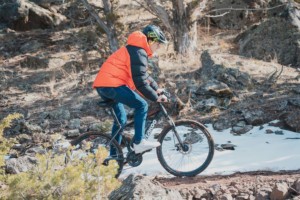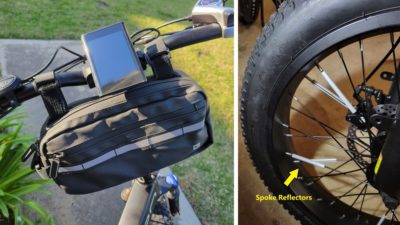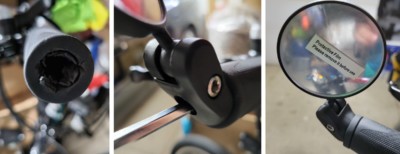HeyBike Cityrun Electric Cruiser Bike
Pros
- Strong 500W acceleration and 7-gear ride
- Detachable, long-range 720Wh battery
- Beautiful design and color scheme
- Attention to detail and turn signals
- Features not available on many eBikes
Cons
- Heavy at 62 lbs
- Throttle disabled when PAS is 0 (Off)
- May be too powerful for some
- No replacement keys available
- Glossy fenders made of weak material
Contents
Beautiful Cruiser eBike
This bike was stunningly beautiful with some unusual attention to detail. It really was in-person and my neighbor commented about its orange color the moment he saw it out for its first test ride.
My parents retired a year ago after decades of working 14+ hour shifts at their donut shop every… single… day of the year. It was time for them to enjoy their lives and to further bond with the grandchildren they love. My 5’1″ mom had enjoyed the Jasion EB7 Foldable eBike for some time until one day she fell and injured her face and knee. It shook her to the core and wanted to get a tricycle instead, but I asked that she try one more bike before we gave up on a two-wheeler. She had agreed.
Nearly the same criteria I had wanted for her remained:
- Decent motor to aid with steep inclines
- 7 or 21 speeds/gears for tackling difficult, uphill climbs
- Pedal Assist System (PAS)
- Easy to get on/off for a woman in her 60s
- Comfortable ride with shock suspension
- Low height
- Initially, fat tires for more balance and control, but the weight was too much for her. I now wanted regular tires for her
- Optionally, a large, detachable battery for long rides and convenient charging
Several bikes I had tested were made for riders who were at least 5’3″ tall, had lousy battery life, or had small diameter wheels that would make rides less comfortable for an older woman. The Jasion EB7 Foldable Electric Bike checked every box I was looking for, EXCEPT at a minimum height of 5’2″, it was still an inch too tall for her. Yes, an inch apparently made a difference for my mom as she could not get off safely without injury.
This time I wanted her to try the HeyBike Cityrun cruiser electric bike. It had normal tires, seemed to have a lower seat height requirement, and looked very comfortable to ride on — except, I made a mistake: it actually required the rider to be at least 5’5″ tall. So, it was not suitable for my mom and had to be returned (sorry, HeyBike!), but I wanted to write a review for it anyway because it was such a darn good eBike.
Why An eBike?
Electric bicycles have enabled our family to travel longer distances and visit more places even though many riders still shun them. They feel that motor assistance is cheating, and I agree! Biking is as much a sport as it is recreational: on one hand, there are those who want to challenge their physical abilities, and on the other, it is a more leisurely way to explore and bond with family and friends. Two children have steered the competitive me towards the latter as seeing the joy on their faces has even trumped the thrill I used to seek on the mountain trails. Towing them in our Burley D’Lite 2-Seat Trailer (with 45-100 lbs extra) was no joke: cramping up during a trip made for a PAINFUL ride home! That was when I really started to appreciate electric bikes — the motorized assistance on the uphill climbs and during the final return miles with tired legs had been a welcome blessing!
Bike or Scooter?
Electric scooters are more nimble to move around with — and in some cases, more fun — but local laws may prevent them from going onto the same paths as electric bicycles. Most can also be carried around more easily due to their more compact size and lighter weight. Personally, I prefer bikes because they are safer to operate, can (usually) go onto the same places that mechanical bicycles can operate, are (generally) allowed to carry an additional passenger, and if the battery runs out or fails, you can still pedal around. A scooter would stop functioning without a battery.
Analysis
The HeyBike Cityrun 26″ Electric Bike with Shimano 7 gears was a stunningly beautiful bike. It was packaged well and the attention to detail by the manufacturer was immediately noticeable through a unique set of features, a well-written manual, and on-frame labeling. There were some minor gripes, but I will get to them later. The orange color stood out, was unexpectedly pleasant to look at, and the bicycle was VERY fun to ride! Whichever team designed it, made the color choices, and selected the handle and seat material and color scheme should pat themselves on their backs for an artistic job well-done. It truly wowed me after having reviewed SO MANY electric bikes. Let’s get right into it:
Performance
Ride performance, like many electrical bikes, was clean, smooth, and comfortable thanks to its front suspension to smooth out bumps. Shock absorption level could be adjusted for increased pedaling efficiency. The motor’s 500W of (nominal) power was strong, holding a 43% advantage over both my dad’s Metakoo Cybertrack 100 and my Googo SY26 mountain eBikes. That meant a very sudden, rapid speed increase that could feel out of control at times, but my mom had previously handled the similarly powered Jasion EB7 like a champion after a few minutes of riding. So, I expect any rider to be able to adjust to it as well. 500W felt much zippier and smoother than my Googo’s 350W motor and handled hills with less effort. Shifting between gears — both mechanically and between the Power Assist Levels (PAS) — was smooth and effortless but hang on to your seat when set to PAS 5 as the speed picked up VERY fast to 20 mph!
As I had stated, shifting between the 7 gears was effortless with a thumb and finger control mechanism, and even though the tires were not the fat kind, they still gave a very satisfying sound while zipping around the neighborhood park and up a few climbs. Power Assist (PAS) was available in 5 levels, and speed topped at 22 mph without a rider. Legally, electric bikes cannot go faster than 20 mph to fall under the United States Class 2 designation, and in California, only Class 2 can ride on Class 1 bike paths. What does that mean? This bicycle’s motor was just fast enough to fall within the California speed limit. Either way, be sure to check with your local and State laws before you push the HeyBike to its top speed.
Electronic controls found on the left side of the handlebar were easy to use and managed the headlight, horn, turn signal, PAS level, power, and monochrome display. The screen was easily readable under direct sunlight and provided a nice set of information, including battery and Power Assist levels, speed in mph, trip time and odometer, and more. I loved the animation when switching between the various data views — small touches like that could evoke a small amount of joy from the rider. I
Programming options were available on the screen to control various settings — See PROGRAMMING section for more details. The display itself gave a brief summary of what each configuration was for — very nice touch!
Dual, hydraulic disc brakes allowed for faster, more controlled stopping.
The large 720Wh-capacity, Li-Ion battery (15Ah @ 48V) gave the HeyBike a VERY significant advantage over any of the bikes I had previously tested, including my Googo’s 360Wh. Battery could be fast-charged (at 218.4W, 54.6V @ 4A) — I appreciated this a LOT as most eBikes took 6+ hours to fully charge (HeyBike’s required about 3-4 hours). Longer runtimes with a more powerful motor, although also with quite a bit of weight at 61.7 lbs: 35-55 miles on fully-electric and 45-70 miles with pedal assist. My experience found that it should theoretically be able to handle at least 140 miles with PAS only used for short uphill climbs. I prefer pedaling most of the time for exercise/health purposes and only invoke the motor just enough to get up a hill. This can be done by twisting the throttle found on the right side of the handlebar: the more you turn it, the more power is invoked on-demand. That leads me to some of the things I did not like about this bicycle.
Unlike the Metakoo Cybertrack 100, every bike I had tested could not activate the throttle while PAS was turned off or set to level 0, the HeyBike included. This perhaps is a safety feature to prevent accidental acceleration when power assist was disabled, but I really enjoyed Metakoo’s implementation because it allowed me to always pedal unassisted and ONLY power on the motor when I turned the throttle. The HeyBike (and all other bikes) required changing the PAS to level 1 before the throttle could temporarily be activated. One would then have to change PAS back to 0 for non-motorized operation. It is a very minor gripe that I got over very easily with my Googo, and it perhaps is best for the rider’s safety to NOT allow on-demand assist with PAS off.
There were four (4) power modes:
- Fully electric: No pedaling necessary
- PAS – Pedal Assist System: Get assistance while pedaling
- Motor off: Move bike with the power of your own legs ;-)
- On demand: Turn handlebar thumb throttle to manually increase speed and motor assist level
The battery was made of Lithium-ion Nickel Manganese Cobalt (NMC) chemistry. What that means is a 20-25% capacity loss after every 500 charge cycle, resulting in about 6-10 years with up to 2,000 cycles before the battery would become useless.
HeyBike Cityrun’s 62 lbs made it one of the heavier eBikes (Polarna M4 was 68 lbs) due to a larger battery and strong motor.
When the battery was out, the higher number of gears would allow easier, more effective, manual pedaling than eBikes without any gears.
Two keys were included and required to operate the bike. So, do NOT lose them! I was, however, very pleased to see that unlike the Jasion, this HeyBike did not make the rider keep the key locked in the ignition underneath the down tube for which one had to crouch down for. Instead, the key was only needed to lock/unlock the battery to/from its frame for off-bike charging. THANK YOU, HeyBike, for making life easier for the rider! When the battery was locked in within the thick down tube, the display showed “Off” when there was no power.
The HeyBike had an exceptionally clean, streamlined look with cables tucked away nicely.
Attention To Detail
This part brought me the most joy. Rather than seeing much of the same old eBikes, the Cityrun had some nifty features and choices made behind its design.
- The bright headlight and large taillight both turned on automatically (when LCD was powered on) once it was dark, but could also be manually turned on/off when the LCD was shut off
- Both the front headlight and rear taillight housed yellow turn signals activated by a switch on the left handle — NICE!
- A cup holder was attached to the seat tube (oddly, a rarity with eBikes)
- Reflective material along the circumference of the tires for greater visibility when crossing intersections
- Leather-like, stitched look on the handles and seat
- Informative LCD with some animations
- Programming options were nicely summarized for each configuration item (a rarity among all bikes I had previously reviewed)
- Strong rear rack with 50lb load capacity (Consider rear rack seat cushions)
- Beach cruiser-like fenders to keep water, dirt, and mud away from the rider’s clothing
- Excellent color choice and scheme all along the frame for an eye-catching look
- Cranks had labels painted on that showed which direction to turn the pedals in to install. I wished that more manufacturers would do that!
- Bluetooth connectivity with the HeyBike smartphone app for firmware updates, automatic lock/unlock via phone, ride statistics, and customization options
- Adjustable handlebar stem for a more comfortable riding height
- Bolt cover for weather proofing
- Quick-release front wheel for quick removal and tire changing
- Well-written manual (although some details were missing but likely not noticeable for many)
- Solid tools included. Some manufacturers had included tools made of weak material that would only be usable one time, if at all
Assembly
Where HeyBike paid a lot of attention to the overall design of the bike, assembly required a bit more effort than I would have liked. Mind you, an experienced installer would have no trouble putting all parts together, but I had perhaps been spoiled by the likes of Jasion and Polarna M4 where their bikes were nearly ready to ride out-of-the-box. Not this Cityrun.
First, one had to install the adjustable handlebar stem. I had later discovered that a plastic, round piece right above the fork was sticking out a bit and required me to uninstall the stem to adjust that particular piece. Somebody at the factory did not pay attention during assembly. Then the handlebar, headlight, and front fender had to be installed (that is normal for every eBike I had tested). Next, I inserted the quick-release skewer through the front wheel and tried to install it to the fork — could not do that until I found a protective, plastic piece between the disc brake that had to be removed. Finally, connected the electronic cables for the headlight, LCD, and taillight, and installed the seat post and pedals. Voila! Good to go! I was happy to see that the disc brakes did not require any tuning, but the tires had no recommended pressure ratings printed onto them. The manual did state to pump between 35-60 PSI.
One concern I had about the otherwise excellent quality of the HeyBike were the fenders. They were made of a shiny, thin material that could easily break AND were held to the frame by screws. That posed a particularly difficult situation for the rear one: it would be nearly impossible to replace the fender because it would be very tight for a screwdriver to reach. It would likely require a specialized, angled screwdriver or a flat-out removal of the rear tire before the fender could be worked on. So, pray that the rear fender never breaks. HeyBike could perhaps have used a more durable material and easier-to-reach mounting mechanism, but that would likely take away from the premium look the Cityrun commanded.
Serial number was etched onto the bottom front of the stem. Be sure to register it with law enforcement in the event of a recovery.
HeyBike included a fast-charging, 218.4W AC brick to charge the battery within about 3-4 hours. The battery could be left charging within the down tube or removed for energizing by your desk.
Final Thoughts
Overall, I was very pleased and quite surprised by the design, color scheme, and performance of the HeyBike Cityrun cruiser electric bike. It was a shame that it was too tall for my mom as I really wanted her to ride it, but alas, the search for a more suitable bike continues. I may throw the towel and finally get her an electric trike (tricycle).
Either way, the HeyBike Cityrun comes highly recommended as a great-looking, very functional eBike where the manufacturer had put in a lot of attention to detail.
Read on for tips or check out the Cityrun’s current price on Amazon.
Tips
Maintenance
- Before first use, charge the battery fully
- Covered charging port is on the side of the down tube
- AC charging brick LED: Red = Charging. Green = Full
- Lithium-Ion batteries are known to be volatile and could catch on fire
- Do not charge overnight or unsupervised for prolonged periods of time. Stop charging once full
- Do not leave the bike in full sun or below freezing
- Keep battery charged at 50% or more to prolong battery’s 500+ cycle lifespan. Try to never let it drain completely
- Lithium-Ion batteries lose about 20-25% of capacity after every 500 charging cycle
- Before riding, check the tire pressure (35-60 psi max) and tighten any loose screws
- Ensure seat post is locked and tight
Operations
- Motor: Turn on display by long pressing the Power button on the controller
- Set Pedal Assist to level 1 or higher by pressing “+” button. Motor kicks in as you pedal
- Throttle the thumb accelerator by the left-side handle, and the motor will fully take over (Power on demand)
- The more you push, the faster the bike will go
- To power off the motor so you would only be able to pedal manually, press Power button (Pedal only), set PAS to level 0 on the display, or turn off the display
- Headlight: Press the Light button. Display does not need to be turned on. Headlight automatically turns on when it is dark and the display is on
- Electronic Horn: Press the Horn button. Display does not need to be turned on
- Walking power assist: Press and hold “-” button for 2 secs to activate motor at low speed
- Helps with walking the bike uphill at 3.7 mph (6 km/h)
- As battery neared empty, I noticed that maximum speed gradually lowered
- Do not brake hard. Doing so could make you painfully tumble, skid, and/or wear out the tires
- Be aware of unexpected obstacles. I tumbled once while mountain biking and was hurt quite badly. It was not fun
Aircraft Transport
Most, if not all, airlines prohibit electronic scooters and bikes that do not meet specific criteria. United Airlines, for example, allows collapsible ones whose battery is both removable and below 300 Wh. Southwest Airlines is more restrictive at 160 Wh. This bike’s battery is 672 Wh. Lithium-ion batteries are known to be volatile, and the higher their capacity, the more risky they are. Check with the airlines, TSA, and FAA for more details.
Bike Assembly
Here are some installation tips for those assembling their first bicycle. There is a diagram below to identify the major bike parts.
Bike Repair Stands
I use a repair stand to help with assembly and maintenance. SereneLife SLBKRS3 has a maximum load capacity of 66.7 lbs — enough to carry most electric bikes without falling over.
For easier maintenance or assembly, a bike repair stand can save a lot of time and back pain. Be sure to get one that can hold up your bicycle’s weight.
Bike Parts
Programming
To enter programming mode: Press and hold both the “+” and “-” buttons until “U03” shows on the LCD. Cycle through the options with the “M” button, change values with “+” or “-“, and save the changed setting(s) by leaving the screen for a few seconds or long-pressing “+” and “-“.
Program Options
PROGRAM AT YOUR OWN RISK! Improper use may void warranty and/or cause bike to fail or be damaged.
Note: I did not take an extensive look at the different settings and what ranges or options were available for each since I had no intent of keeping the bicycle.
User Settings
- U03: Power-On Gear. Default: Last
- U04: Temperature unit. “F” or “C”. Default: F
- U06: Odometer Reset. Default: 1
Advanced Settings
- P01: Backlight brightness level. Default: L-3
- P02: Unit display. 0 = kilometers (km/h), 1 = miles (mph). Default: 1
- P03: Do not modify. Battery Voltage. Default: 48
- P04: Automatic Sleep. Default: 0
- P05: PAS levels. Default: 0-5
- P06: Do not modify. Wheel Diameter. Default: 27 (inches?)
- P07: Do not modify. Number of magnets for measuring speed. Default: 1
- P08: Maximum speed. 0-63. 63 = No limit. Default: 20 (mph?)
- Changing limit to 63 will allow the motor to run at its full capacity. I was only able to get it to 21.5 mph (with no rider)
- Can result in overheating and cut motor’s life short. Going over 20 mph may be illegal in your State or country
- Changing limit to 63 will allow the motor to run at its full capacity. I was only able to get it to 21.5 mph (with no rider)
Warning: Configuring maximum speed to go past 20 mph can overheat the motor and cut its life short. Going that fast may also be illegal in your State or country.
- P09: Non-0 Start. Default: 0
- Whether the motor can start when bike is not in motion. Should be left off to prevent bike from accidentally moving during transport
- P12: Assist strength. Default: 3
- P13: Assist magnet number. Default: 12
- P14: Do not modify. Current limit. Default: 22
- Ensure this is set to what the controller and hub motor can handle
- P52: Handle function. Default: Yes
- P53: Handle 6km. Default: No
Error Codes
I did not take an extensive look at the different error codes and possible fixes. However, if I remember correctly, they were listed in the manual.
Motor Bike Laws
I first learned about laws governing motorized scooters when reviewing the Joyor X5S, and unfortunately, they were (and still are) not straight-forward. There had been a number of accidents involving scooters hitting pedestrians or riders hurting themselves. I get it. Laws are there to protect people from each other and themselves, especially from irresponsible individuals.
Electric bikes can result in severe injuries or death with their high speeds.
Surprisingly, the laws governing electric BIKES are much more lax. They are similar to non-motorized bikes, in fact! There are different classes of eBikes. This HeyBike falls under the lower-speed Class 2 with a maximum of up to 20 mph, and as such, can be used on Class 1 bike paths in California. All 3 classes can ride on the protected, one-way Class 2 bike lanes found on streets and highways. Be sure to check with your local regulations. Some States categorize eBikes as mopeds or motor vehicles.
- Class 1: PAS-only with no throttle. Max assisted speed: 20 mph
- Class 2: PAS and throttle. Max assisted speed: 20 mph
- Class 3: PAS-only with no throttle. Max assisted speed: 28 mph
California Law
Disclaimer: I AM NOT A LAWYER. Please consult your local city, police department, and/or legal professional for advice.
The following is my interpretation of how I understand the law. It has been shortened to only point out parts that I found interesting or noteworthy.
- Does NOT require riding with a Driver’s License or Instruction Permit (eScooters require them!)
- No license plate required
- Passengers are allowed as long as the bike was designed for it
- Can ride on existing bike infrastructure
- Speed limited to 20 mph
- Follow most of the same laws as non-motorized bicycles
- Helmet required for riders 17 years and younger
- No minimum age limits
Accessories
Some accessories I recommend for this bike for added convenience and safety:
- Molik Bike Handlebar Bag
- Salzmann 3M Spoke Reflectors: For increased visibility in the dark
- Bar End Bike Mirrors (like BriskMore, Tagvo, or Zacro): To see behind you
- Rear rack seat cushions
- Burley Trailer Coupler: So trailer can be switched to another bike (ie. bike failed or ran out of battery)
Where To Buy
- HeyBike Cityrun Cruiser Electric Bike
- Accessories
- Molik Bike Handlebar Bag
- Salzmann 3M Spoke Reflectors
- Bar End Bike Mirrors: BriskMore, Tagvo, Zacro
- Rear rack seat cushions
- Burley D’Lite 2-Seat Bike Trailer/Stroller
- Additional Trailer Coupler so Burley can be switched to another bike (ie. bike failed or ran out of battery)
Related Posts
- Reviews
- Polarna M4: 20″ foldable, electric bike with 750W motor, 8 speeds (30mph+), and 4″ fat tires
- Jasion EB7: 20″ foldable, electric, 7-speed bike with fat tires, 500W motor, 20mph max
- Googo SY26: 26″ electric mountain bike with 21 speeds, large informative LCD, electronic headlight and horn, and solid build
- Metakoo Cybertrack 100: 26″ electric mountain bike with 21 speeds and a clean look
- Ancheer AM001907/AN-EB001: 26″ electric mountain bike with 21 speeds, electronic headlight and horn, and powerful, rapid acceleration
- Macwheel Ranger 500: Comfortable, 7-speed, electric cruiser for city commutes
- Gyroor C3: Single speed, electric, semi-foldable, and priced fairly low
- How to Quickly Teach a Child to Ride a Bike (Balance With No Training Wheels)
- Bike USA Stabilizer Wheels for Adult Bicycles

